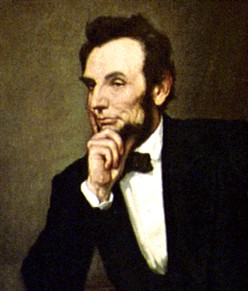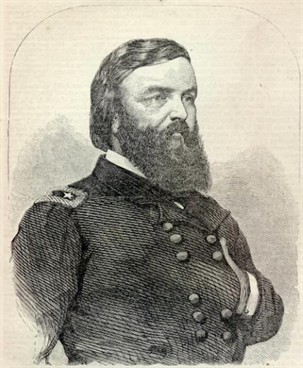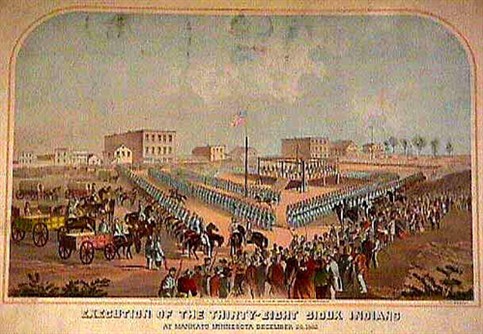The Santee Sioux uprising in
Minnesota, ultimately put down by General Sibley, exposed
conflicting forces that were soon to erupt in violent conflicts on
the Great Plains. This uprising - as were most
uprisings - resulted from 1) a failure of the federal government to
make good on treaty promises; 2) a refusal to enforce restrictions
on an encroachment by white settlers, or 3) a combination of
both.
click here for more
The Santee
Sioux uprising in October of 1862 was a confrontation over treaty
rights (stemming from 'a combination of both') that President
Lincoln was ill prepared to manage from distant Washington.

Bureaucratic
delays in paying Indian annuities (see Annuity System
failures) lay at the heart of this conflict, as the destitute and
hungry Sioux faced starvation at the onset of winter. Their
agent's tireless efforts to get them food had come to naught, while
his supplier was on the record as stating: "So far as I'm
concerned, if the Sioux are hungry let them eat grass or their own
dung."
In August, six
young warriors raided a farm in Acton, killing five white
settlers. From this incident violence spread like a prairie
fire throughout southwestern Minnesota. Before the uprising
could be contained more than 350 whites lay dead in the largest
massacre of whites, by Indians, in the nation's history.
Lincoln was so
fixated on Robert E. Lee's forays into Maryland that he had little
time for Indian affairs on the frontier. He sent General Pope
(below) - fresh from a humiliating defeat at the Second Bull Run,
to take charge of the situation, but Pope approached the assignment
with resentment and transferred his anger to the Sioux.
When he arrived in Wisconsin he found "panic everywhere," and
predicted an all out Indian War would break out unless the Indians
were severely punished. He announced to his troops that
his objective was to "utterly exterminate the Sioux if I have the
power to do so...and they are to be treated [by us] as maniacs or
wild beasts."

Minnesota
officials liked this man. Here was an opportunity to use
Pope's animosity toward the Indian to rid themselves of their red
neighbors and take ownership of all their lands. Pope's
command broke the back of the rebellion in October and a military
commission put more than 1,500 Indians on trial in a notorious
spectacle.
President
Lincoln was the first to admit that he was poorly informed on
Indian affairs. John Ross, the Cherokee chief, urged him to
offer military protection to the Cherokees who had fallen under
confederate control, but he dodged the challenge by replying that
he had his hands full with the war in other places. Like most
whites of the time, Lincoln regarded Indians as a barbarous race of
people who were obstacles to progress. When at their most
patronizing, Washington politicians enjoyed visits by Indians
chief. They brought color and exotic culture to the city,
where men like Lincoln spoke to them in pigeon English and
explained that the world 'is a great, round ball.'
click here for more
By early
November, Pope sent Lincoln a list of 303 Sioux men the military
court had found guilty and condemned to die. Lincoln ordered
complete transcripts of the trials, and after reading them (over
the protests of an indignant Pope), he commuted the sentences of
all but thirty-nine. When he heard of the commutations,
Senator Morton (Minn.) threatened Lincoln with an ultimatum:
"Either the Indians must be punished according to law, or they will
be murdered without law."

Thirty-eight Sioux were hanged at a public executiion in
Mankato, Minnesota
On December 26,
in the largest public execution in American history, thirty-eight
men swung from the gallows (one more had been pardoned at the last
moment). Lincoln's clemency of the others set off a firestorm
of rancor among whites that carried over into the next
election. Republicans lost strength in Minnesota in the
election of 1864, which took place the same month as the Sand Creek
Massacre in Colorado. Governor Ramsey admonished the
president that had he hanged more Indians he would have received a
much larger majority.
"I cannot
afford to hang men for votes," Lincoln replied.